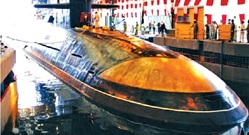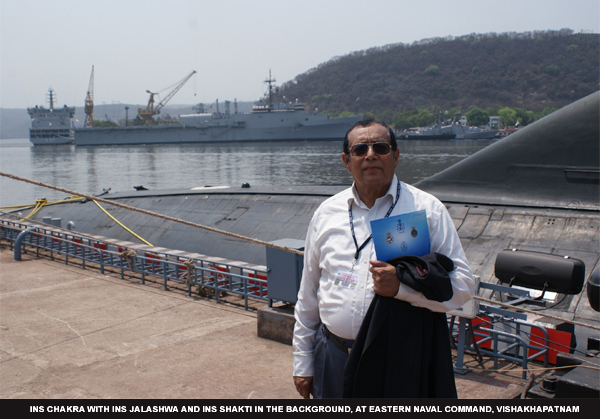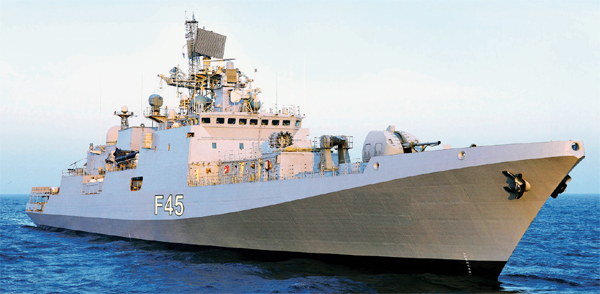|
 The
Fast Forward pace after a long lull has been mentioned
both by Defence Minister AK Antony as well as
Chief of the Naval Staff Admiral Nirmal Verma
on different occasions, particularly at the induction
of the nuclear-powered submarine INS Chakra Apr
4. Since then, the Navy has inducted the first
of its newly-designed Teg class guided missile
ships, INS Teg, from Russia (Apr 27) while plans
are being firmed for building four amphibious
transport dock ships like the INS Jalashwa, as
well as six new conventional submarines with Air
Independent Propulsion (AIP) and cruise missile
capability. The
Fast Forward pace after a long lull has been mentioned
both by Defence Minister AK Antony as well as
Chief of the Naval Staff Admiral Nirmal Verma
on different occasions, particularly at the induction
of the nuclear-powered submarine INS Chakra Apr
4. Since then, the Navy has inducted the first
of its newly-designed Teg class guided missile
ships, INS Teg, from Russia (Apr 27) while plans
are being firmed for building four amphibious
transport dock ships like the INS Jalashwa, as
well as six new conventional submarines with Air
Independent Propulsion (AIP) and cruise missile
capability.
Two INS Deepak class fleet tankers have already
been acquired from Italy to give the Indian Navy
what Admiral Verma described as “Long Legs.”
The Navy has been very happy with INS Jalashwa,
the refitted USS Trenton (LPD 14) it got rather
cheap from the US Navy, particularly due to the
vessel’s added potential for disaster and
humanitarian relief capability. It’s the
second biggest ship after INS Viraat, the Navy’s
lone aircraft carrier at present, has comfortable
crew quarters and efficient lifts.
Interestingly, naval personnel are making innovative
use of cycle rickshaws to pedal small items from
one end to another. Electric carts though are
standard on its various levels.
Reports from Russia indicate that the much-delayed
INS Vikramaditya aka Admiral Gorshkov is now ready
for sea trials beginning May 25. Fuel has been
pumped into the vessel and steam is being generated
before it moves into the cold waters for trials
and final checks.
Russia had promised delivery to the Indian Navy
by 4 Dec 2012, the Navy Day this year. The date,
according to Vice Admiral Mahadevan, is “cast
in stone” but the delivery will be in Russian
waters. It should be on the Indian shores early
2013.
It may be recalled that the Navy has already
inducted two of the three Shivalik class frigates
in 2010 and 2011 respectively (INS Shivalik and
INS Satpura) while the third in the series, INS
Sahyadri, is due this year.
Admiral Verma told India Strategic earlier that
while the acquisition process could be “torturous
some times,” adequate funds were available
for the Navy’s modernization and that due
care was also been given to its shipboard air
power.
Overall, the Navy has planned to acquire some
500 aircraft, about 100 of them combat, and the
remaining for transport and surveillance roles.
Helicopters form a major chunk.

The 45 Mig 29Ks that it has already ordered from
Russia, will only be used on board the INS Vikramaditya
and India’s first indigenous aircraft carrier
now under construction. Both these will have ski
jumps and arrested wire recovery (STOBAR).
Notably, the Russians have modified the arrester
wires on INS Vikramaditya already to accommodate
the naval variant of India’s indigenous Light
Combat Aircraft (LCA), the naval prototype (NP-1)
which was test flown April 27.
India is working on two more aircraft carriers,
possibly of over 60,000 tonnes, and it will take
some time to select the combat jet combination
for them. Those two carriers should use slingshot
propulsion by steam turbines rather than ski jumps,
and of course, the standard three arrestor wires.
That technology will possibly have to come from
the US carriers where slingshot takeoffs are routine.
Naval teams area already in touch with manufacturers
as part of the learning process, after which RfPs
should appropriately be issued.
French company DCNS is already involved in making
six Scorpene submarines at the Mazagon Dock in
Mumbai, with a proposal to upgrade the last two
of them with AIP capability, which can extend
the operational submergence of a submarine from
about three days to seven or so.
As for the nuclear submarines, which can stay
underwater for three months, the Indian Navy is
working on two or three more Arihant class submarines,
but they should progressively be equipped with
more powerful nuclear reactors and weapons than
INS Arihant, whose systems are now being fine-tuned.
INS Arihant is smaller than INS Chakra, but is
both nuclear powered and nuclear weapon capable
(designated SSBN) while INS Chakra is nuclear
powered but has non-nuclear attack missiles (SSN).
Both the nuclear submarines are based at Vishakhapatnam
on India’s eastern seaboard, where work on
the remaining nuclear submarines is already in
progress at the Ship Building Centre (SBC) there
in different stages.

|